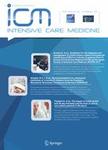版权所有:内蒙古大学图书馆 技术提供:维普资讯• 智图
内蒙古自治区呼和浩特市赛罕区大学西街235号 邮编: 010021

作者机构:Erasmus Med Ctr Rotterdam Dept Pulm & Intens Care Med NL-3015 GD Rotterdam Netherlands
出 版 物:《INTENSIVE CARE MEDICINE》 (抢救护理医学)
年 卷 期:1999年第25卷第8期
页 面:799-804页
核心收录:
学科分类:1002[医学-临床医学] 1011[医学-护理学(可授医学、理学学位)] 10[医学]
基 金:Dutch Asthma Founda Nederlands Astma Fonds
主 题:flow-volume curve mechanical ventilation exhalation valve intensive care
摘 要:Objective: To assess the feasibility of expiratory flow-volume curves as a measurement of respiratory mechanics during ventilatory support: to what extent is the shape of the curve affected by the exhalation valve of the ventilator? Design: Prospective, comparative study. Setting: Medical intensive care unit of a university hospital. Patients: 28 consecutive patients with various conditions, mechanically ventilated with both the Siemens Servo 900C and 300 ventilators, were studied under sedation and paralysis. Interventions: The ventilator circuit was intermittently disconnected from the ventilator at end-inspiration in order to obtain flow-volume curves with and without the exhalation valve in place. Measurements and results: Peak flow (PEF) and the slope of the flow-volume curve during the last 50% of expired volume (SF50) were obtained both with and without the exhalation valve in place. The exhalation valve caused a significant reduction in peak flow of 0.3 l/s (from 1.27 to 0.97 l/s) with the Siemens Servo 900 C ventilator and of 0.42 l/s (from 1.36 to 0.94 l/s) with the Siemens Servo 300 ventilator (p 0.001). The SF50 was not affected. Conclusion: In mechanically ventilated patients, the exhalation valve causes a significant reduction in peak flow, but does not affect the SF50. This study further suggests that the second part of the expiratory flow-volume curve can be used to estimate patients respiratory mechanics during ventilatory support.